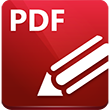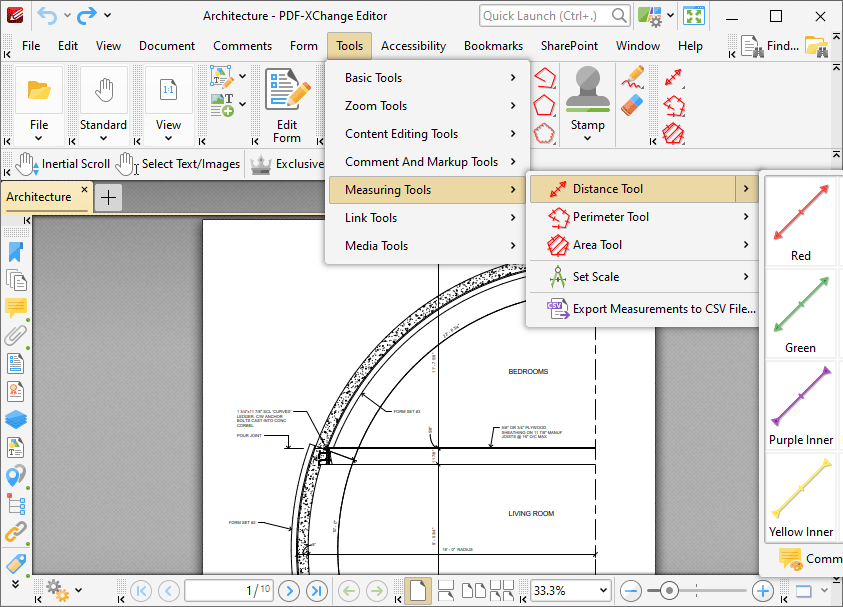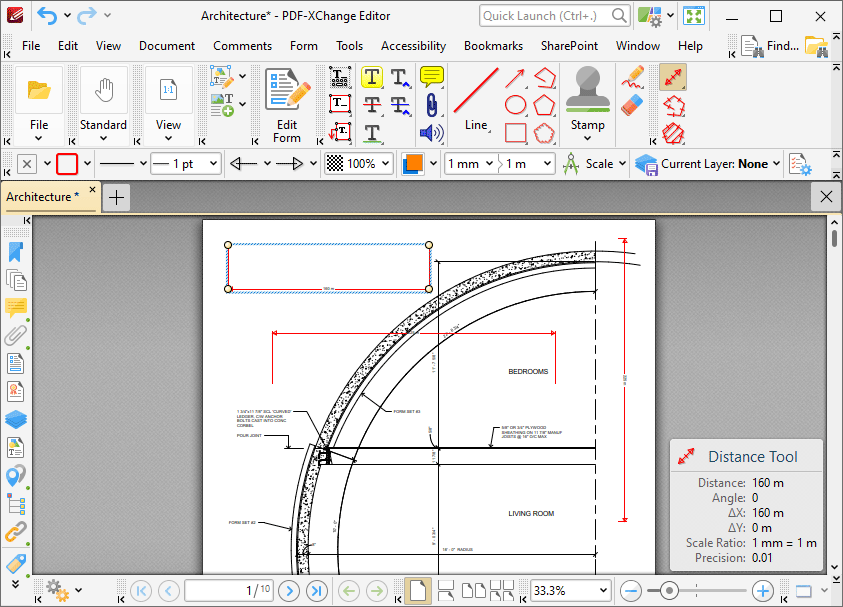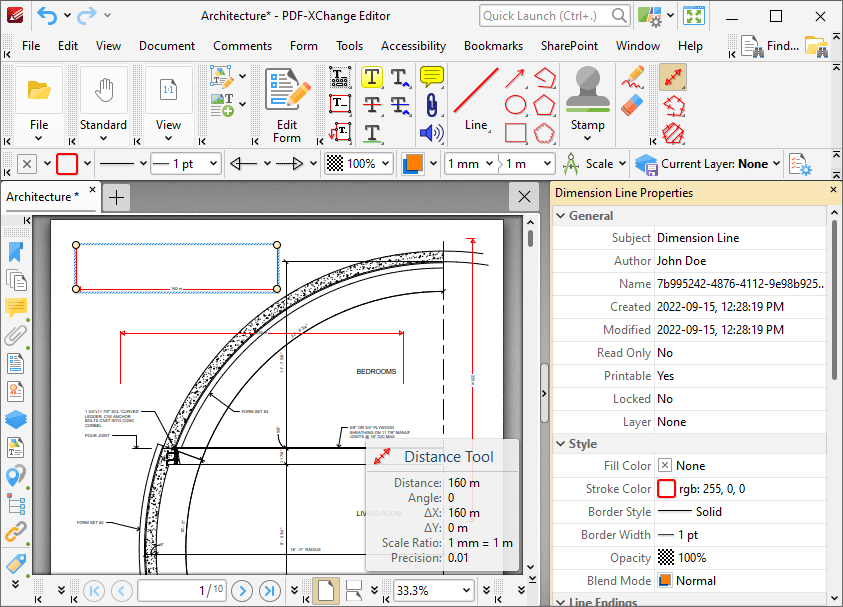 Distance Tool
Distance Tool
Click Distance Tool to add distance measurement annotations to documents:

Figure 1. Tools Tab Submenu, Distance Tool
When the Distance Tool is selected the pointer becomes a crosshairs icon. Click to designate a starting point for the distance annotation. A red arrow will appear and the Distance Tool information box will be displayed in the lower right corner of the active window. Drag the crosshairs to the desired finishing point. The distance from the start point will be displayed as the pointer is moved, and further details will be displayed in the information box. Click to determine the measured distance. The baseline is then established. Click again to set the baseline as the final measured distance. Alternatively, move the pointer up/down to reposition the baseline at a parallel position within the document and create perpendicular leader lines at either end. Click to complete the process:

Figure 2. Distance Tool Examples
•The Distance Tool calculates and displays distances measured according to the active scale. The Scale option in the Properties Toolbar is used to determine the active scale. The scale reference figure will be displayed above the line. Right-click lines and select Open Pop-Up Note to customize the appearance of the scale reference figure.
•Click and drag the control points at either end of the baseline to adjust the length of the adjoining perpendicular lines.
•Click and drag the second pair of control points to adjust the length of the baseline and the angle of the annotation.
•Click and drag lines to reposition them.
•Use the arrow keys to reposition lines. Hold down Shift to move at an increased increment.
•Use the editing aids detailed here to assist in the precise placement of lines.
•Hold down Shift to create lines at increments of fifteen degrees.
•Right-click lines for further options. See here for an explanation of these options.
•When the Distance Tool is selected, the following options are enabled in the Properties Toolbar:
•Fill Color determines the fill color of the Line Starting/Ending Styles, detailed below, when closed-shape options are used.
•Stroke Color determines the color of lines.
•Border Style determines the style of lines.
•Border Width determines the size of the Line Starting/Ending Styles, detailed below.
•Line Starting Style determines the style used at the start of lines.
•Line Ending Style determines the style used at the end of lines.
•Opacity determines the level of transparency in lines.
•Blend Mode determines how lines blend with underlying content. These options are explained here.
•The Scale number boxes can be used to determine the scale of selected objects. Alternatively, click Scale to select/manage predefined scales or calibrate a new scale.
•Keep Selected determines whether or not the Distance Tool remains selected after a line has been created. If this option is enabled then the tool will remain selected and can be used to create several lines consecutively. If this option is not enabled then PDF-XChange Editor will revert to the designated default tool immediately after creating the line.
•Exclusive Mode simplifies the process of using the Distance Tool. When Exclusive Mode is enabled, the pointer ignores all interactive elements of documents other than base content. This makes it possible to create lines on areas that overlap with other content without the risk of accidentally selecting undesired items. When Exclusive Mode is disabled, the pointer recognizes and interacts with all underlying elements in the usual manner.
•Click Properties to view/edit additional distance annotation properties, as detailed below.
•Note that several default styles are available for distance tool annotations, as detailed in (figure 1). Click to select alternative annotation styles. The Comment Styles Palette can be used to save customized distance line styles for subsequent use. Right-click the Distance Tool icon in the Comment Toolbar to view existing styles and/or access the Comment Styles Palette.
Dimension Line Properties Pane

Figure 3. Dimension Line Properties
•Subject is the name of the distance annotation, as referenced in the Comments pane.
•Author is the name of the user that created the distance annotation.
•Name is the unique name of the distance annotation, as referenced within the application.
•Created is the date and time at which the distance annotation was created.
•Modified is the date and time at which the distance annotation was last modified.
•Read Only is the read only status of the distance annotation. If this property is enabled then users cannot interact with the annotation. Please note that it is necessary to use JavaScript to change the value of this property.
•Printable is the print status of the distance annotation. If this property is enabled then the annotation is printed with the document. If this property is not enabled then the annotation is not printed.
•Locked is the locked status of the distance annotation. If this property is enabled then the annotation cannot be deleted and its properties (including its position and size) cannot be modified by users.
•Layer specifies the optional content layer to which the distance annotation belongs. Further information about layers is available here.
•Fill Color determines the color of the line ending style used at the start of the distance annotation. The line ending property is detailed below.
•Stroke Color determines the color of the distance annotation.
•Border Style determines the style of the annotation.
•Border Width determines the width of the annotation.
•Opacity determines the level of transparency in the distance annotation.
•Blend Mode determines how distance annotations blend with overlapping content. These options are explained here.
•Start determines the line ending style used at the start of the distance annotation.
•End determines the line ending style used at the end of the distance annotation.
•Start Scale determines the size of the line ending used at the start of the distance annotation.
•End Scale determines the size of the line ending used at the end of the distance annotation.
•Leader Length determines the length of the leader lines used for the distance annotation. Leader lines extend from each endpoint of the distance annotation, perpendicular to the annotation itself.
•Leader Extension determines the length of leader line extensions that extend from the distance annotation.
•Leader Offset determines the length of the leader line offset, which is the amount of empty space between the endpoints of the distance annotation and the beginning of the leader lines.
•Show Caption determines whether or not the text contained in the pop-up note of the annotation is displayed.
•Inline Caption determines whether or not the caption is an inline caption. If this option is enabled then captions are placed inside the distance annotation instead of on top of the distance annotation.
•Length determines the length of the distance annotation.
•Total Distance displays the total distance of the annotation. If you have multiple distance annotations selected then the total length of the annotations will be displayed for this property.
•Avg. Distance displays the average distance of the annotation. If you have multiple distance annotations selected then the average length of the annotations will be displayed for this property.
•Min. Distance displays the minimum distance of the annotation. If you have multiple distance annotations selected then the length of the shortest annotation will be displayed for this property.
•Max. Distance displays the maximum distance of the annotation. If you have multiple distance annotations selected then the length of the longest annotation will be displayed for this property.
•Scale determines the scale used for the distance annotation. Further information about scales is available here.
•Label determines the text label displayed with the distance annotation.
•Precision determines the precision with which scale conversions are displayed.
•Group determines the symbol used as the group separator.
•Decimal determines the symbol used as the decimal separator.